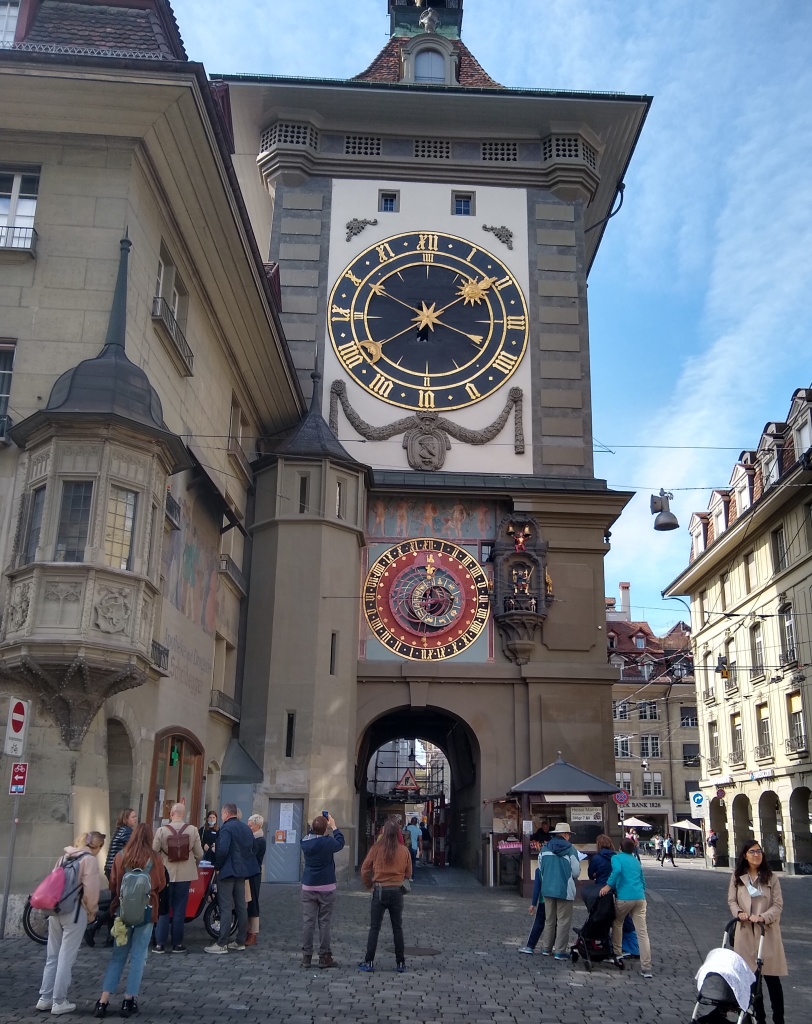The class of unified theories that I’ve been studying for the last 14 years had a minor but annoying problem, but I was afraid to tackle it until this summer. And suddenly, it’s led me into a strange new world where I had to re-think quantum mechanics from the ground up.
Here’s the problem: In General Relativity, or even just Special Relativity plus the Einstein Equivalence Principle (that gravity and acceleration feel the same because they ARE the same), you get Gravitational Time Dilation. Einstein first worked this out in 1907, and got that the time dilation factor had to be Td = 1 + 𝚽/c² to first order. This can also be written Td = 1 + m𝚽/mc² = 1 + ∆E/mc²; here we emphasize that the last term can be written as a ratio of energies. 𝚽 is the gravitational potential, m𝚽 is the potential energy of a mass m at potential 𝚽, and mc² is the rest mass energy of the same mass.
But Einstein also noted that the linear formula couldn’t be exactly right. The reason is simple. Let’s say you and I run an experiment with synchronized start and stop, and you measure S₁ seconds on your clock, and I measure S₀ seconds on my clock. Then the time dilation I see you as having is Td(1<-0) = S₁ / S₀, and the time dilation you ascribe to me is Td(0<-1) = S₀ / S₁. It must always be the case that Td(1<-0) * Td(0<-1) = (S₁ / S₀) * (S₀ / S₁) = 1, exactly. But using the linear formula, we get Td(1<-0) = 1 + 𝚽/c² and Td(0<-1) = 1 – 𝚽/c², and so Td(1<-0) * Td(0<-1) = (1 + 𝚽/c²) * (1 – 𝚽/c²) = 1 – (𝚽/c²)². It’s not exactly 1.
Einstein wrote that the exact formula had to be Td = exp(𝚽/c²) = exp(m𝚽/mc²). This fixes the problem. This exponential dependence of time on energy is inescapable in relativity theory.
When we look at quantum mechanics, we see something similar. Wave functions that are higher in energy rotate their quantum phase faster, those that are lower in energy rotate their phase more slowly. And in fact if we use the total-energy which includes the rest mass energy (as Schrödinger himself did in his letter to Willy Wien), and consider E = h𝜈, we get the identical linear formula Td = 𝜈₁ / 𝜈₀ = ((mc² + ∆E)/h) / (mc²/h) = (mc² + ∆E) / mc² = 1 + ∆E/mc².
So, we would like to treat the phase frequency shifts in QM as being identical to the time dilations seen in GR, especially for the case of putting a gravitational potential into the Schrödinger equation. But while they are identical to first order, the linear equation in QM is exact; this appears forced by E = h𝜈 which implies 𝜈 = E/h. And the linear equation in GR is not quite correct; the exponential form is the exact one. So the two phenomena almost agree perfectly, but not quite.
This had been annoying me for years, but I didn’t know what to do about it. There’s no way to change the GR equation without breaking something. And hacking QM seemed insane; it’s one of the most successful theories in the history of science, and there were multiple papers published saying that any non-linear modification of it would have massive consequences, such as destroying causality. It seemed a far too difficult problem for me to tackle.
But early this year I came across another paper that said some nonlinearities might be tolerable. Without going into the details, I felt that this gave me a license to try. So I did. And it turned out to be much easier than I expected.
The normal Schrödinger equation is:
iℏd/dt 𝛙 = Ĥ 𝛙
This gives the correct eigenfunctions (e.g. atomic orbitals), but the implied phase frequency is 4 orders of magnitude too low. We have to add in the rest mass energy to get the frequencies right:
iℏd/dt 𝛙 = (mc² + Ĥ) 𝛙
This “total energy” version of the Schrödinger equation is what we want to match as closely as possible. To get an exponential time dependence, we could try an equation that had exp(Ĥ) in it, but that doesn’t work. The power series expansion gives:
exp(Ĥ) = 1 + Ĥ + Ĥ²/2! + Ĥ³/3! + …
and this doesn’t make dimensional sense, because the terms have dimensions of dimensionless (1), energy (Ĥ), energy squared (Ĥ²/2!), and so on; they can’t be added together. Taking a hint from the GR equation Td = exp(m𝚽/mc²), we can try normalizing by dividing by mc²:
exp(Ĥ/mc²) = 1 + Ĥ/mc² + Ĥ²/2!(mc²)² + Ĥ³/3!(mc²)³ + …
This makes dimensional sense since all the terms are dimensionless. But it doesn’t quite match the Schrödinger equation; we want the first two terms to be mc² + Ĥ. We can fix this by multiplying through by mc²:
mc²exp(Ĥ/mc²) = mc² + Ĥ + Ĥ²/2!mc² + Ĥ³/3!(mc²)² + …
which matches the standard (total energy) equation to first order in Ĥ. So our new quantum equation is:
iℏd/dt 𝛙 = mc²exp(Ĥ/mc²) 𝛙
or, defining a new operator X̂ ≡ mc²exp(Ĥ/mc²), simply
iℏd/dt 𝛙 = X̂ 𝛙
This defines a new version of quantum mechanics that I call Exponential Quantum Mechanics or XQM.
We now need to figure out what this breaks, and what it doesn’t. What I know so far:
- X̂ is Hermitian. X̂† = mc²exp(Ĥ†/mc²) = mc²exp(Ĥ/mc²) ≡ X̂
- Spatial eigenfunctions are unchanged. Any eigenfunction 𝛙n of Ĥ with eigenvalue En is also an eigenfunction of X̂ with eigenvalue mc²exp(En/mc²). This means that e.g. chemical bond lengths and angles are unchanged.
- Frequency is now an exponential function of energy. This matches gravitational time dilation perfectly. But, it means we have to give up thinking that E = h𝜈 is universally true.
There’s a lot more work to do here, including trying to do the same thing with the Dirac equation. But so far, so good. I managed to hack the Schrödinger equation to warp its time behavior without breaking much; in particular, all of chemistry is unaltered. Not bad for an amateur. 🙂











